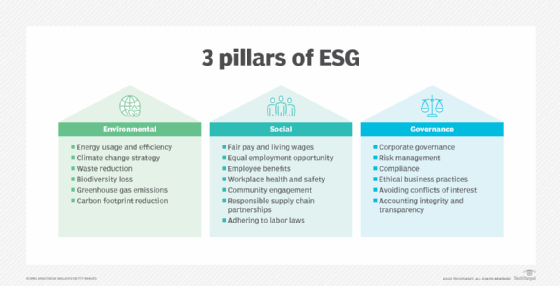
Getty Images
ESG audit vs. green IT audit: How are they different?
Companies often struggle with understanding how to start sustainability reporting. Learn the distinct roles ESG audits and green IT audits play in a complex reporting landscape.
In today's business landscape, where sustainability efforts are gaining traction, IT leaders need to become familiar with new types of audits.
The environmental, social and governance (ESG) and sustainability landscape is confusing. But CIOs should understand the difference between ESG audits and green IT audits since technology teams are likely to be part of both. In a nutshell, the first is a broader examination of the organization's sustainability efforts. The latter is focused on IT sustainability. Here's a closer look.
What is an ESG audit?
An ESG audit -- or a sustainability audit -- promotes flexibility and transparency by reporting on a company's ESG risks and opportunities. These elements might include reviews of the firm's operations, culture and other factors. The audit provides measurable data to both internal and external sources to help evaluate the organization's policies and understand existing practices.
ESG is applicable to the business, and how it addresses environmental, social and governance issues from a risk perspective. The following issues are addressed in an ESG audit, which examines how the organization addresses each domain:
- Environment. This focuses on the firm's policies, procedures, and culture toward issues such as climate change, waste management, energy usage and carbon emissions.
- Social. This focuses on the firm's commitment to diversity, equity and inclusion; relationships with investors and other stakeholders; ethical practices; and encouraging employee involvement in the community.
- Governance. This focuses on general business practices, diversity among board members, performing ethical accounting and financial practices, structured reporting practices and risk management.
A key component in ESG audits is the use of specific measurable key performance indicators, or KPIs. Sustainability leaders can develop these indicators from the many ESG frameworks, such as the Global Reporting Initiative standards.
Not only is collecting relevant data necessary, but processing the data into meaningful reports provides audit evidence. Specialized software can be helpful for facilitating data collection, processing and reporting. Accurate data reporting addressing ESG metrics is critical.
ESG audits might also reflect the organization's corporate social responsibility (CSR). An effective CSR program can present a positive public image, which can boost stakeholder and investor confidence. Companies interested in collecting this type of data might find ISO Standard 26000:2010, Guidance on social responsibility, can be helpful in this aspect. While it's not a compulsory standard, its guidance can be critical in establishing or refining a CSR program. It can also be a source of CSR, sustainability and ESG KPIs.

The ESG audit portion focused on IT
Environmental, social and governance controls also apply to the IT organization. The IT-focused portion of the ESG audit focuses on the following issues:
- Environment for IT audit. This focuses on the IT department's policies, procedures and culture on issues such as energy usage, waste management and carbon emissions. These elements might complement related green IT audit controls.
- Social for IT audit. This focuses on the IT department's commitment to diversity, equity and inclusion, particularly in its hiring practices and employee involvement in the company.
- Governance for IT audit. This focuses on operational policies, procedures and practices, and risk management.
This list is not a green IT audit, however.
What is a green IT audit?
Green IT audits differ from an ESG, or sustainability, audit in some unique ways.
Green IT audits examine IT infrastructure, such as hardware, software, networks, physical security and data center buildings, and how these various elements affect the environment. Green IT audit controls typically address energy conservation, reduction of carbon footprints and recycling of IT assets. Further audit controls examine how the IT department minimizes the environmental effects of its many different infrastructure elements.
A green IT audit can ideally stand separately from an ESG audit. The two might complement each other, but two questions emerge. Should IT auditors with tech expertise be the same auditors for an ESG audit? Or should there be two separate audit teams using the same frameworks to gather similar data? Such decisions depend on what the organization wants to focus on with each audit. Senior management can offer insights into that decision.
Paul Kirvan is an independent consultant, IT auditor, technical writer, editor and educator. He has more than 25 years of experience in business continuity, disaster recovery, security, enterprise risk management, telecom and IT auditing.








